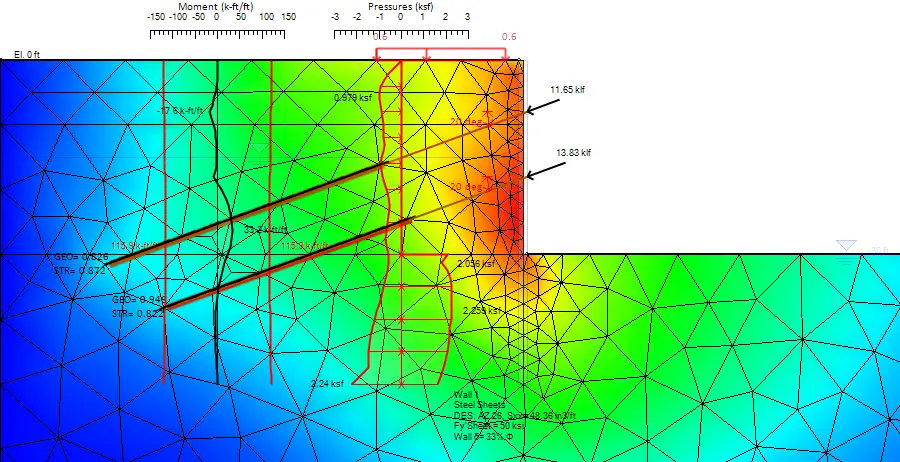Comparing Helical Anchors and Conventional Tiebacks
- deepexcavation
- Oct 6
- 4 min read
Designing Efficient Excavation Support Systems with DeepEX
In modern geotechnical engineering, selecting the right anchoring system is a critical step in ensuring both the safety and efficiency of deep excavation projects. Engineers today have access to a range of solutions, but two of the most prominent are conventional tieback anchors and helical anchors (or helical piles used as ground anchors). Each has its own set of mechanical principles, construction methods, and performance characteristics that influence cost, schedule, and overall design strategy.
With DeepEX, engineers and contractors have a unified software environment that allows them to analyze, compare, and optimize both systems within a single digital platform. Rather than committing to one anchoring method prematurely, users can model alternative solutions, evaluate their interaction with soil and structural systems, and determine the most efficient configuration for any given project.

Image 1: Deep excavation with tiebacks in Athens, Greece – Project designed with DeepEX
Conventional Tiebacks: Strength and Reliability Through Grouted Bond
Conventional tiebacks have long been considered the standard solution for deep excavation support. They are typically installed by drilling an inclined borehole through the retained soil and into a competent layer, inserting a steel tendon or strand, and filling the borehole with cement grout. Once the grout cures, the anchor is tensioned to apply a prestress force that stabilizes the retaining wall.
The primary advantage of this system lies in its high load capacity and adaptability to a wide range of soil conditions. Tiebacks can be extended to considerable depths and are capable of developing large tensile forces by mobilizing bond strength along the grouted length. This makes them particularly well-suited for deep excavations, permanent structures, and sites where hard strata or rock formations are present.
However, tiebacks also come with construction challenges. Drilling, grouting, and curing require time and specialized equipment, which can complicate schedules, especially in urban environments where space is limited. Groundwater can also pose difficulties during installation, and the overall process generates more noise and spoil compared to screw-type systems.
Despite these factors, tiebacks remain a reliable, well-understood solution — one that is easily analyzed and optimized in DeepEX, where engineers can simulate load transfer, grout bond zones, and wall performance under a range of ground conditions and loading scenarios.

Image 2: Sheet pile wall with tiebacks – FEM analysis with DeepEX
Helical Anchors: Rapid Installation and Immediate Capacity
Helical anchors represent a modern alternative that has gained traction in both temporary and permanent support systems. A helical anchor consists of a steel shaft fitted with one or more helical plates, which are literally screwed into the soil using a hydraulic drive. The anchor resists tension primarily through bearing on the helical plates and friction along the shaft.
The greatest advantage of helical anchors is installation speed. They require no drilling or grouting, and can often be installed using compact equipment — a significant benefit in restricted-access sites, sensitive environments, or urban areas where vibration and noise control are paramount. Because they develop capacity as they are installed, they can be loaded immediately, eliminating delays associated with grout curing.
Helical anchors are also easily removable, making them ideal for temporary works such as braced excavations, shoring systems, or slope stabilization projects where the anchoring system is not required permanently. The installation torque provides a direct correlation to the load capacity, offering a simple and practical verification method in the field.
However, their use can be limited in dense soils, cobbles, or rock, where penetration becomes difficult or impossible. Their overall capacity is also generally lower than that of large grouted tiebacks, which may restrict their application in very deep or heavily loaded projects.
In DeepEX, engineers can simulate helical anchor behavior, model their interaction with the retaining wall, and directly compare their predicted performance against traditional tiebacks under identical conditions — an invaluable feature for making data-driven design decisions.

Image 3: Sheet piles with helical anchors - LEM analysis with DeepEX
Efficiency Analysis with DeepEX
The true power of DeepEX lies in its ability to bring both systems into a single, integrated design and analysis framework. Instead of running separate calculations or relying on external spreadsheets, engineers can model their excavation geometry, wall types, soil stratigraphy, and anchoring systems — whether helical or conventional — within one unified platform.
Through Efficiency Analysis, DeepEX allows direct comparison between anchoring methods. Engineers can evaluate each system’s structural performance, factor of safety, installation depth, and cost implications in real time. This functionality empowers designers to identify the most efficient solution not only from a geotechnical and structural perspective but also from a constructability and economic standpoint.
DeepEX’s advanced analysis capabilities include nonlinear soil-structure interaction, multiple construction stages, groundwater effects, and seismic considerations. The software’s intuitive interface and automatic reporting features make it easy to communicate results with contractors and clients, promoting transparency and collaboration from design to execution.

Image 4: Model with ground anchors – Automatic optimization options in DeepEX
Bringing It All Together
Both conventional tiebacks and helical anchors play vital roles in modern excavation support design. Tiebacks offer unmatched strength and depth capability, while helical anchors deliver speed, simplicity, and adaptability. The challenge for today’s engineers is not deciding which is “better” in general, but determining which is better for a specific project — given the soil profile, site constraints, and performance requirements.
With DeepEX, that decision becomes clear. The software equips engineers and contractors with the analytical power to simulate both systems accurately, assess their relative efficiency, and make confident, cost-effective choices. Whether your project demands high-capacity permanent anchors or rapid, low-impact temporary solutions, DeepEX ensures you have the right tools to design with precision and insight.
DeepEX — one platform, endless possibilities for smarter, safer, and more efficient excavation design.
Let us show you how to reduce your design time by up to 90%!




